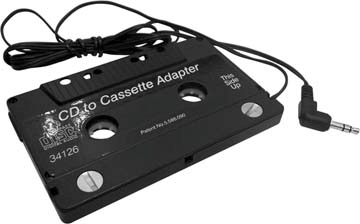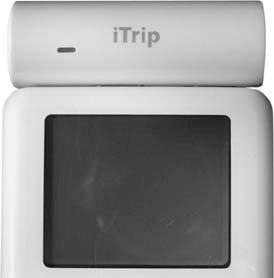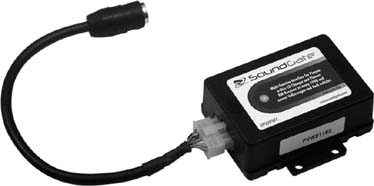Hack14.Get Computer Audio into Your Head Unit
Hack 14. Get Computer Audio into Your Head Unit
Aftermarket CD changers and DVD players have become very popular of late, as have MiniDisk players, MP3 players, and legions of other small audio devices. To use these devices in a car, however, you'll need to smuggle the audio into your (usually closed) head unit. The concept of getting audio into the car stereo is almost completely foreign to automobile manufacturers, who tend to run years behind state of the art when it comes to audio technology. And the concept is familiar but threatening to aftermarket manufacturers, who want to lock you into buying their CD changers and their navigation units, not allow easy use of your own laptop or MP3 player. Fortunately, there are several ways that you can get audio into your head unit. 2.4.1. Tape AdaptersA tape adapter (Figure 2-5) looks like a cassette tape with a wire coming out of it and a mini headphone plug (2.5 mm) on the end. The headphone jack plugs into your external audio device. Tape adapters have a magnetic output device that converts the sound coming in the wire into magnetic signals like those on a normal cassette tape. Figure 2-5. A tape deck adapter Tape adapters are the cheapest solution for audio input; they can be purchased for $1020 and they plug in and work right away. They are the quickest way to get your computer or MP3 player's audio into the car's head unit, and they work quite reliably. However, from an audio perspective, tape adapters are a pretty low-fidelity solution. For one thing, the audio signal goes through multiple translationsfrom the source, through a wire, through a magnetic head, read back by a tape head, then amplifiedand it loses a bit of quality in each step. Additionally, the spindles that move the tape are rotating for no reason, and these scraping rotors and their motors generate both electrical and audible noise. ("Reduce Your Audio System's Noise" [Hack #17] has a tip on how to partially solve this problem.) Finally, cassette playback was never that clean to begin with. Even the highest-end tape deck with Dolby noise reduction never rivaled the clean sound of CDstape decks always have a bit of noise and hiss. 2.4.2. FM ModulatorsIf you ever connected a video game system to a television in the mid 1980s, you are familiar with the concept of FM modulators. An FM modulator takes an input signal (audio or video) and rebroadcasts it on a particular station frequency. A relatively nonintrusive way to get a head unit to play external audio is to simply broadcast it on some frequency that isn't used in your area. VCRs do this all the timeif your TV doesn't have auxiliary input (the yellow, white, and red RCA connectors), your VCR simply broadcasts its signal on channel 3 or 4. You set your TV to that channel, and voilà, you have video. FM modulators of all kinds usually have a range of frequencies, either at the low or high end of the frequency band, so that you can adjust them to some station that isn't being broadcast in your area. For instance, your adapter might have a switch to choose between 88.1MHz, 88.3MHz, 88.5MHz, and 88.7MHz. Another adapter might have the choices 106.7MHz, 106.9MHz, and 107.1MHz. The sound quality of FM modulation can vary a lot, depending on the quality of the FM receiver and the quality of the FM modulator (and the amount of local interference by other broadcasters). Some small portable FM modulators, such as the iRoq or other similar units for iPods (see Figure 2-6), are battery operated, have a small range, and simply need to be positioned near the FM receiver head unit. Other FM modulators, such as those built into aftermarket CD changers, splice directly into the antenna connector for the car. This allows a stronger FM signal that can override a competing signal from the airwaves and allow your external audio to work consistently. If you often drive on long-distance trips and don't want to have to keep changing the station every time another competing station pops into range, a more permanent FM modulator such as this is probably your best bet. Figure 2-6. The iTrip FM modulator The sound fidelity range of FM is limited and is only about two-thirds the range that a CD can faithfully reproduce. As a result, FM modulation is never the best for audio fidelity. (Though MP3s may add audio glitches, they can produce sounds all the way up to the 22,500-KHz range; FM only goes up to about 14,000 KHz.) 2.4.3. Auxiliary-in AdaptersAlmost all modern head units, factory or aftermarket, can control some sort of CD changer. While there are hundreds of different CD changer models, each of these boils down to a similar interface: button presses are sent to a CD changer, and audio comes back from the CD changer. This same interface can often also be used as a simple auxiliary-in (AUX-in) adapter, as shown in Figure 2-7. A whole industry exists around building replacement CD changers for factory and aftermarket head units, and these same vendors provide AUX-in adapters as well. Some of the AUX-in adapters even have multiple inputs with a switch. If your head unit already has a factory CD changer attached to it, these switching head units will allow you to toggle between the CD changer and several other inputs. Figure 2-7. An AUX-in adapter for a Volkswagon The sound quality of AUX-in can vary somewhat, because the expected sound input volume level of the AUX adapter isn't necessarily the same from head unit to head unit. But it is usually far better than tape adapters or FM modulation. 2.4.4. Aftermarket Head UnitsIf you can't find the right adapter for your factory head unit, or you want to upgrade your stereo anyway, the simplest way to get auxiliary input is to buy an aftermarket head unit that includes an AUX-in plug. Most of the mid- to high-end units have them these days, because they are already being used to integrate DVD players and video game systems. I've used Pioneer head units, and while the mid-range units don't come with AUX-in plugs on the back, they are compatible with an adapter I know I can purchase cheaply. Higherend units usually have a pair of RCA jacks for AUX-in built in. 2.4.5. Digital InputsWhile not common yet, some high-end stereo systems are designed to provide full six-channel surround sound for DVD playback in the vehicle. Instead of running six individual wires, you can use digital optical sound links to move the audio around. If you are considering using one of these systems in conjunction with an in-car computer, you may be able to use the optical digital output of the computer (nonintuitively named S/PDIF) to send your audio straight into the head unit. As home entertainment systems are redesigned to fit the mobile entertainment market, more and more "digital" features will show up in vehicles. The gradual convergence of PCs and audio/video entertainment makes such high-end systems easy to integrate with an in-car computer. 2.4.6. Adjusting Input VolumeThe main problem with any analog audio input solution is one of balancing the volume of the audio source with the expected input volume of the adapter. A factory CD changer always outputs its audio to the head unit at a constant volume, and the head unit then amplifies it to the volume selected by the user. When a computer or other device is connected to a head unit through any of these analog methods, audio distortion can result from mismatched volume. If the computer volume is too low, the head unit volume has to be turned higher. This will add hiss and digital noise. And when you switch back to normal radio, your speakers are likely to blast your ears off because your head unit's volume is turned up too high. Conversely, if the computer volume is too high, the head unit volume has to be turned down. This can result in clipping, where input volume is so high that the higher-frequency sounds are "cut off" and don't come through, resulting in distorted audio even at low volumes. One solution to this problem is to balance your computer or other device's volume to the right level through trial and error, but the ideal solution is to get unamplified output from your computer or device. The iPod, for instance, actually has two audio outputs: an amplified, volume-adjustable headphone output on top, and a single-volume output that comes out of the bottom dock connector. Similarly, some PC sound cards have both a headphone out and an amplified out for connection to speakers. If you're using a computer, always use the unamplified or lightly amplified output; if you're using another device, use a fixed-volume output (if one exists). The term line-level describes a certain voltage between 0.5V and about 4V. Ideally, line-level is the kind of output you would like. Another term you will encounter is preamplified, which is the kind of signal you want for an auxiliary input. A preamplified signal is several volts, but is not designed to actually power speakers or headphones. It's a strong, clean signal, with no distortion. The best signal is from a device or sound card that outputs a preamplified line-level signal of around 4 volts. 2.4.7. Choosing Your AdapterTape adapters are cheap and easy to install, but they are the least clean installation (an unsightly wire hangs out of your tape player). They also require you to have a tape player in the first place. They are all similar in sound quality; the only difference I have seen is in the quality of the cable that runs to them. You can buy a Sony model in almost any electronics store, and these sound better than generics. FM modulators are very consistent in their operation and work in almost in any vehicle. They range from cheap $30 battery-powered adapters to perhaps $80 for an installed hideaway version. A reputable installer has told me that there are differences between FM modulators, and that brand-name units from Clarion and other manufacturers probably do a better job than cheaper models. I've personally had poor luck with the iRoq and other portable, battery-powered FM broadcasters. In some cars, however, the iRoq works well, and I know people who swear by it. Auxiliary-in adapters, when they work right, are the best-sounding analog connections. When installed and working correctly, these give you the highest quality sound possible, as good as you would get from a factory CD changer or other integrated device. They range in price from $25 to over $100. If you are doing a permanent installation of a computer in a recent (510 years old) vehicle that has a CD changer option, chances are one of a variety of vendors makes an AUX-in adapter for your vehicle. The biggest names in aftermarket AUX-in adapters are:
Although this book is about in-car computers, it's hard to ignore the dominating presence of the iPod as an in-car audio device. iPods sound best with AUX-in adapters, and each of the manufacturers listed above also makes special iPod adapters that allow control of the iPod via the head unit [Hack #18]. If you have upgraded or are going to upgrade your car to a high-end head unit with digital inputs, you're far ahead of the game. Your computer can integrate with such a unit as easily as with a DVD player or other high-end entertainment device, with extremely high quality and fidelity. The digital (optical or coaxial S/PDIF) inputs available on some of the newest car amplifiers will provide the cleanest audio solution, but you may not be able to control the audio volume easily from your stereo head unit. These products start at several hundred dollars and go up depending on the make of the amplifier and whether it comes as part of a multipart stereo system.
2.4.8. Multiplexing Your InputsAs a final note, you may have a whole handful of devices that you need to connect in addition to your computer. To switch between various input sources, you can use a three-way audio or audio and video switch [Hack #35]. The switches are just like those you might use on your TV set to switch between video games, DVDs, and TV. You can choose between, say, your DVD player, your portable MP3 player, or your in-car computer. If you mount these switches in your center console or glove compartment, you can easily access them without hanging a bunch of wires across your dashboard. |
